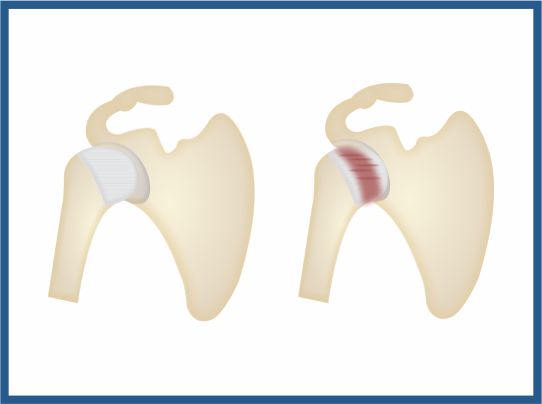Adhesive Capsulitis/ Frozen Shoulder-In frozen shoulder, the shoulder capsule thickens and becomes stiff and tight. Thick bands of tissue — called adhesions — develop. In many cases, there is less synovial fluid in the joint.
The hallmark signs of this condition are severe pain and being unable to move the shoulder.
It develops in three stages:
- Stage 1: Freezing In the "freezing" stage, you slowly have more and more pain. As the pain worsens, your shoulder loses range of motion. Freezing typically lasts from 6 weeks to 9 months.
- Stage 2: Frozen Painful symptoms may actually improve during this stage, but the stiffness remains. During the 4 to 6 months of the "frozen" stage, daily activities may be very difficult.
- Stage 3: Thawing Shoulder motion slowly improves during the "thawing" stage. Complete return to normal or close to normal strength and motion typically takes from 6 months to 2 years.

Causes
The causes of frozen shoulder are not fully understood. A few factors may put you more at risk for developing frozen shoulder.
Diabetes - Frozen shoulder occurs much more often in people with diabetes. The reason for this is not known. In addition, diabetic patients with frozen shoulder tend to have a greater degree of stiffness that continues for a long time before "thawing."
Other diseases - Some additional medical problems associated with frozen shoulder include hypothyroidism, hyperthyroidism, Parkinson's disease, and cardiac disease.
Immobilization - Frozen shoulder can develop after a shoulder has been immobilized for a period of time due to surgery, a fracture, or other injuries. Having patients move their shoulders soon after injury or surgery is one measure prescribed to prevent frozen shoulder.
Symptoms
- Pain
- Difficulty in moving the shoulder
- Overhead activity is painful
- Restricted all directional movement
- Crepitus
- Stiffness
- Tenderness
- Difficulty in Daily routine activities like combing, wearing clothing reaching across the table
Treatment
Treatment
Nonsurgical Treatment
- Non-steroidal anti-inflammatory medicines
- Steroid injections- Cortisone is a powerful anti-inflammatory medicine that is injected directly into shoulder joint.
- Hydrodilatation- This procedure involves gently injecting a large volume of sterile fluid into the shoulder joint to expand and stretch the shoulder joint capsule.
- Physical therapy- Specific exercises will help restore motion. Sometimes heat is used to help loosen the shoulder up before stretching.Below are examples of some of the exercises that might be recommended
Surgical Treatment
- Surgery is often necessary to repair torn or stretched ligaments so that they are better able to hold the shoulder joint in place.
- Arthroscopy. Soft tissues in the shoulder can be repaired using tiny instruments and small incisions.Arthroscopy is a minimally invasive surgery.
- Open Surgery- This involves making a larger incision over the shoulder and performing the repair under direct visualization.
methods include manipulation
Manipulation under anesthesia. During this procedure, you are put to sleep. Your doctor will force your shoulder to move which causes the capsule and scar tissue to stretch or tear. This releases the tightening and increases the range of motion.

